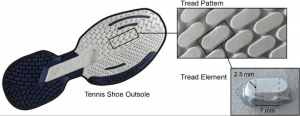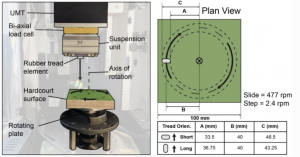A professional tennis player can perform over 1000 direction changes throughout a match. In tennis, players can change direction in two ways: by stepping or sliding. Friction in these direction change movements is affected by the interaction between a player’s shoes and the court surface. A better understanding of this interaction can help improve shoe design.
In a recent study, John Hale and colleagues investigated the impact of tennis shoe design on shoe-surface friction on hard court surfaces. They examined tread patterns, which are the patterns of grooves in the outsoles of tennis shoes. Tread patterns help increase shoe-surface friction.

Instead of analyzing the whole shoe itself, the researchers opted to study the friction of individual tennis tread elements. They replicated the conditions of real-life stepping and sliding movements with a sample hardcourt surface and a rubber tread element. The experimental set-up is shown in this diagram.

Sliding movements were replicated with higher rotational speeds than stepping movements. A sliding movement was defined as a rotation of 477 revolutions per minute, while a stepping movement was defined as 2.4 revolutions per minute.
The researchers found that sliding movements produced higher dynamic friction than stepping movements. In addition, the researchers examined if differences in tread orientation would affect friction. They found that stepping movements with short tread orientations and long tread orientations resulted in similar static friction measures. However, when analyzing sliding movements, they found that a short tread orientation led to greater dynamic friction than a long tread orientation.
Overall, the researchers found that the static and dynamic fiction imposed upon the rubber tread surface caused it to become rougher. Over time, this change in topography may affect the performance of stepping and sliding movements.
Images were obtained from the mentioned paper authored by researcher John Hale and colleagues (article is open access and licensed under a Creative Commons Attribution 4.0 International License)